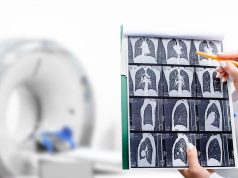Overall performance of radiologists was 0.01 higher in terms of AUC with aid of algorithm
WEDNESDAY, Nov. 4, 2020 (HealthDay News) — A deep-learning algorithm can assist radiologists in detecting cerebral aneurysms on computed tomography (CT) angiography images, according to a study published online Nov. 3 in Radiology.
Jiehua Yang, from the Huazhong University of Science and Technology in Wuhan, China, and colleagues retrospectively retrieved head CT angiography images from two hospital databases acquired between January 2015 and June 2019. The data were divided into training and validation sets, and 400 additional, independent CT angiograms were used for external validation. A deep learning-based algorithm was constructed and assessed.
The researchers evaluated a total of 1,068 patients with 1,068 CT angiograms encompassing 1,337 cerebral aneurysms. Of these, 534 CT angiograms with 688 aneurysms and 534 CT angiograms with 649 aneurysms were assigned to the training and validation sets, respectively. For detecting cerebral aneurysms, the sensitivity of the proposed algorithm was 97.5 percent. Eight new aneurysms that had been overlooked in the initial reports were identified (1.2 percent). In terms of the area under the weighted alternative free-response receiver operating characteristic curve, the overall performance of radiologists was 0.01 higher (95 percent confidence interval, 0.00 to 0.03) with the aid of the algorithm.
“The role of this deep-learning system, which has been trained to recognize aneurysms, is to give suggestions to the human reader to improve their performance and reduce mistakes,” a coauthor said in a statement. “The combined work of the human reader and computer system improves the diagnostic accuracy for the patient’s sake.”
Editorial (subscription or payment may be required)
Copyright © 2020 HealthDay. All rights reserved.








